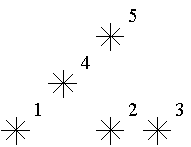POJ-2352 Stars (树状数组,离散,排序)
来源:互联网 发布:院士 知乎 编辑:程序博客网 时间:2024/06/07 05:31
Stars
Time Limit: 1000MS Memory Limit: 65536KTotal Submissions: 49716 Accepted: 21439
Description
Astronomers often examine star maps where stars are represented by points on a plane and each star has Cartesian coordinates. Let the level of a star be an amount of the stars that are not higher and not to the right of the given star. Astronomers want to know the distribution of the levels of the stars.

For example, look at the map shown on the figure above. Level of the star number 5 is equal to 3 (it's formed by three stars with a numbers 1, 2 and 4). And the levels of the stars numbered by 2 and 4 are 1. At this map there are only one star of the level 0, two stars of the level 1, one star of the level 2, and one star of the level 3.
You are to write a program that will count the amounts of the stars of each level on a given map.

For example, look at the map shown on the figure above. Level of the star number 5 is equal to 3 (it's formed by three stars with a numbers 1, 2 and 4). And the levels of the stars numbered by 2 and 4 are 1. At this map there are only one star of the level 0, two stars of the level 1, one star of the level 2, and one star of the level 3.
You are to write a program that will count the amounts of the stars of each level on a given map.
Input
The first line of the input file contains a number of stars N (1<=N<=15000). The following N lines describe coordinates of stars (two integers X and Y per line separated by a space, 0<=X,Y<=32000). There can be only one star at one point of the plane. Stars are listed in ascending order of Y coordinate. Stars with equal Y coordinates are listed in ascending order of X coordinate.
Output
The output should contain N lines, one number per line. The first line contains amount of stars of the level 0, the second does amount of stars of the level 1 and so on, the last line contains amount of stars of the level N-1.
Sample Input
51 15 17 13 35 5
Sample Output
12110
#include <stdio.h>#include <string.h>#include <algorithm>using namespace std;#define maxn 32002int c[maxn], ans[15001];struct point{ int x, y; bool operator < (const point& a){ if(y == a.y) return x < a.x; return y < a.y; }}a[15001];inline int lowbit(int x){ return x & (-x);}void add(int x){ while(x < maxn){ c[x]++; x += lowbit(x); }}int getsum(int x){ int ans = 0; while(x){ ans += c[x]; x -= lowbit(x); } return ans;}int main(){ memset(c, 0, sizeof(c)); memset(ans, 0, sizeof(ans)); int n; scanf("%d", &n); for(int i = 1; i <= n; ++i){ scanf("%d %d", &a[i].x, &a[i].y); a[i].x++; a[i].y++; } sort(a + 1, a + 1 + n); for(int i = 1; i <= n; ++i){ ans[getsum(a[i].x)]++; add(a[i].x); } for(int i = 0; i < n; ++i){ printf("%d\n", ans[i]); }} /*题意:15000个点,对于任意点,问有多少个点在该点的左下方,即x小于等于且y小于等于。思路:先将坐标离散化。然后按y排序,y相等按x排序,然后一个个插入,一个个询问。在某点之前出现的点一定是y小于等于该点的y的,这样只要询问前面有多少个点x小于等于该点的x即可。可以用树状数组解。*/
阅读全文
0 0
- POJ-2352 Stars (树状数组,离散,排序)
- POJ 2352 - Stars 排序后用树状数组处理+离散化
- POJ 2352 Stars 树状数组
- POJ 2352 Stars【树状数组】
- (树状数组) poj 2352 Stars
- POJ-2352-Stars-树状数组
- POJ 2352 Stars 树状数组
- POJ 2352 Stars 【树状数组】
- POJ 2352 Stars 树状数组
- POJ-2352 Stars【树状数组】
- POJ 2352 Stars 树状数组
- poj 2352 Stars 树状数组
- poj 2352 Stars 树状数组
- POJ:2352 Stars(树状数组)
- [树状数组]POJ 2352 Stars
- POJ-2352-Stars 树状数组
- Stars - POJ 2352 树状数组
- poj 2352 Stars 树状数组
- 学完python写爬虫,不亦乐乎
- Android6.0之后动态权限申请
- A previous ephemeral live node still exists. Solr cannot continue. Please ensure that no other Solr
- 解决was8.5下自带log4j和slf4j的jar包与应用中jar包冲突问题
- css盒子模型
- POJ-2352 Stars (树状数组,离散,排序)
- oracle不同数据库表数据同步
- PyCharm:Error running xxx: Cannot run program "D:\Python27\python.exe"
- 算法与数据结构---选择排序
- Android 代码混淆技术总结
- 学会如何使用移动用户反馈系统,让你玩转APP
- 算法与数据结构---插入排序
- PHP之设计模式(二)---基础篇
- C++ 高性能服务器网络框架设计细节


